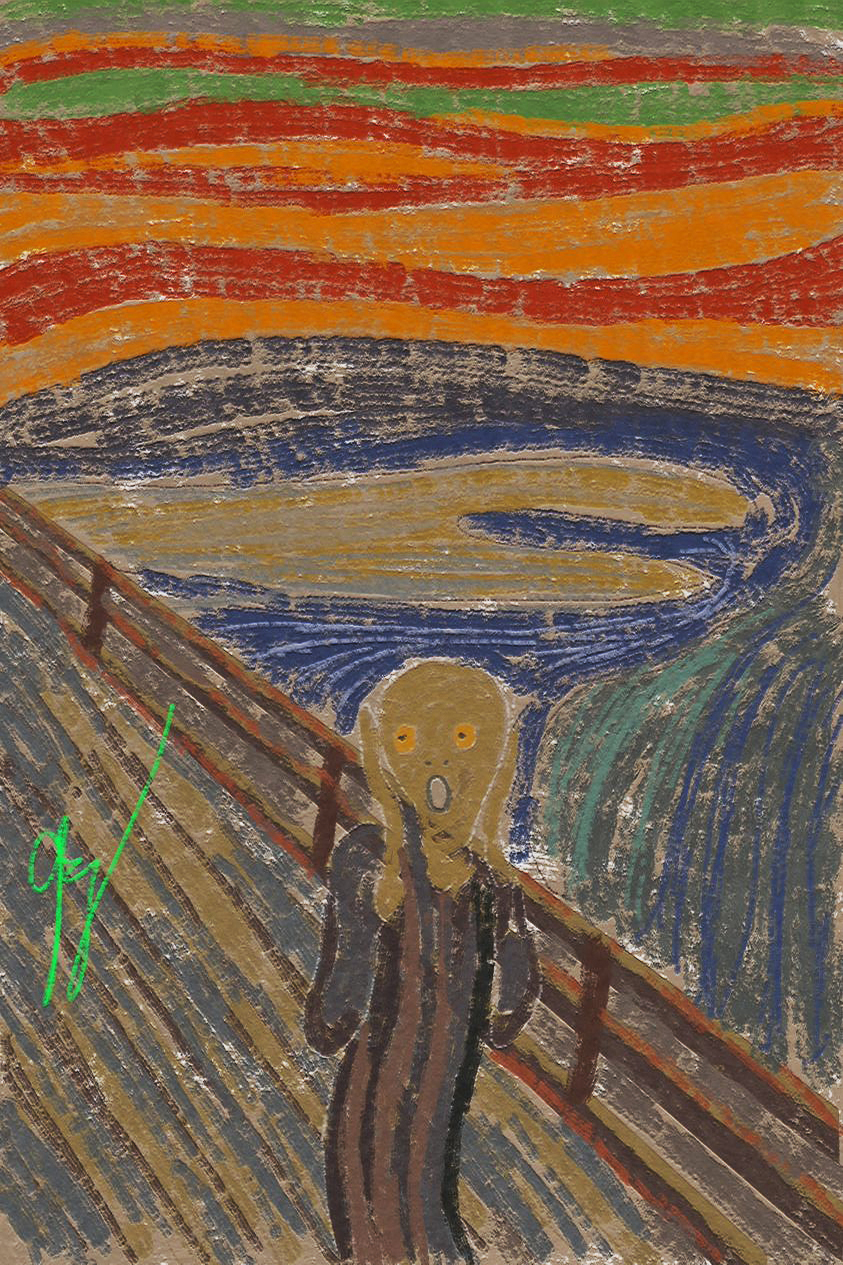
Exploring the World’s Most Depressing Paintings
Art has always been a mirror to human emotion, capturing the highs and lows of the human condition. While many paintings are created to inspire joy or provoke thought, some delve into the depths of despair, offering a hauntingly beautiful glimpse into sorrow, tragedy, and existential angst. Today’s topic explores some of the most depressing paintings in art history and examines why they evoke such profound sadness.
1. “The Scream” by Edvard Munch
One cannot discuss emotionally charged art without mentioning Edvard Munch’s iconic work, The Scream. Painted in 1893, this masterpiece is a visceral representation of anxiety and existential dread. The swirling sky, distorted perspective, and the central figure’s agonized expression encapsulate a moment of overwhelming psychological turmoil.
Munch himself described the inspiration behind the painting: walking along a bridge, he felt a “great, infinite scream pass through nature.” This personal moment of anguish translates universally, as the figure’s scream seems to echo the inner turmoil many have experienced but struggled to articulate.
Why It’s Depressing:
- The palpable sense of panic and despair in the painting is magnified by its warped, nightmarish landscape.
- It reflects the universal human experience of isolation and fear.
2. “Saturn Devouring His Son” by Francisco Goya
This macabre painting by Francisco Goya is a chilling portrayal of raw, primal fear. Part of his “Black Paintings” series, Goya’s Saturn Devouring His Son depicts the Roman god Saturn consuming one of his children to prevent a prophecy that foretold his downfall.
The grotesque imagery—Saturn’s wild eyes, the limp body of his child, and the dark, shadowy background—creates a scene that is both horrifying and heart-wrenching. It’s a bleak commentary on human nature’s capacity for violence and the destructive force of paranoia.
Why It’s Depressing:
- The subject matter is deeply disturbing, reflecting themes of betrayal, fear, and the cyclical nature of violence.
- Goya painted this work during his later years, a time marked by his disillusionment with humanity and declining mental health.
3. “Ophelia” by John Everett Millais
John Everett Millais’s Ophelia is a poignant depiction of the tragic Shakespearean character’s death. Based on the scene from Hamlet where Ophelia drowns after losing her sanity, the painting shows her floating lifelessly in a river, surrounded by lush flora.
The juxtaposition of Ophelia’s serene expression and the vibrant, almost idyllic setting heightens the tragedy of her untimely demise. The detailed depiction of flowers—each symbolizing different emotions like grief, innocence, and love—adds layers of meaning to the composition.
Why It’s Depressing:
- The painting captures the sorrow of a young life cut short, compounded by themes of unrequited love and mental anguish.
- The serene beauty of the scene contrasts sharply with the grim reality of her death, making it all the more heartbreaking.
4. “The Death of Marat” by Jacques-Louis David
This neoclassical painting by Jacques-Louis David memorializes the assassination of Jean-Paul Marat, a radical journalist and revolutionary during the French Revolution. Marat is depicted slumped in his bathtub, where he was killed by Charlotte Corday.
The stark composition—Marat’s lifeless body against a dark background—emphasizes the finality of death. His outstretched arm, still clutching a quill, suggests his dedication to his cause even in his final moments. While the painting venerates Marat as a martyr, it also evokes deep sadness for the brutality of political conflict.
Why It’s Depressing:
- It highlights the senseless violence and loss of life during revolutionary upheavals.
- The intimate setting of the bathtub contrasts with the political implications of his death, making it feel both personal and tragic.
5. “Weeping Woman” by Pablo Picasso
Painted in 1937, Picasso’s Weeping Woman is a harrowing exploration of grief. The distorted features and vibrant yet disjointed colors capture the emotional chaos of a woman overwhelmed by sorrow. This painting was created in response to the bombing of Guernica during the Spanish Civil War, and the woman’s tears symbolize collective mourning for the atrocities of war.
Why It’s Depressing:
- The abstract style amplifies the raw emotion, making the viewer feel the woman’s anguish on an almost visceral level.
- It serves as a reminder of the human cost of war and the enduring pain of loss.
6. “Christina’s World” by Andrew Wyeth
At first glance, Andrew Wyeth’s Christina’s World seems like a peaceful rural scene. However, the story behind the painting imbues it with a profound sense of melancholy. The figure in the painting, Christina Olson, was a real person who suffered from a degenerative muscular disease. Unable to walk, she often crawled across her family’s farmland, as depicted in the painting.
The vast expanse of the field and Christina’s vulnerable position evoke feelings of isolation and helplessness. Her longing gaze towards the distant farmhouse suggests an unfulfilled desire for freedom and normalcy.
Why It’s Depressing:
- The stark contrast between the idyllic setting and Christina’s physical limitations creates a poignant narrative about human resilience and fragility.
- It captures the quiet despair of living with an incurable condition.
7. “Guernica” by Pablo Picasso
Another masterpiece by Picasso, Guernica is a large-scale mural that depicts the bombing of the Basque town of Guernica during the Spanish Civil War. The painting’s fragmented, chaotic composition reflects the horror and senselessness of war. Distorted figures scream in agony, while broken bodies and dismembered animals litter the canvas.
Why It’s Depressing:
- The monochromatic palette and chaotic imagery convey a sense of overwhelming despair.
- It serves as a stark reminder of the destruction and human suffering caused by war.
8. “The Raft of the Medusa” by Théodore Géricault
This monumental painting by Théodore Géricault depicts the aftermath of a real-life shipwreck. Survivors of the Medusa are shown clinging to a makeshift raft, their emaciated bodies and anguished expressions reflecting their desperation.
Géricault conducted extensive research for this painting, even studying corpses to accurately portray the effects of starvation and exposure. The result is a harrowing scene that captures both the physical and psychological toll of survival.
Why It’s Depressing:
- The painting confronts viewers with the fragility of human life and the depths of human suffering.
- It’s a damning indictment of political incompetence, as the shipwreck was caused by poor decision-making.
9. “Nightmares” by Henry Fuseli
Henry Fuseli’s Nightmares is an unsettling depiction of a sleeping woman plagued by a demonic incubus perched on her chest. The oppressive atmosphere and eerie lighting create a sense of unease, mirroring the feeling of being trapped in a nightmare.
Why It’s Depressing:
- The painting taps into universal fears of vulnerability and the unknown.
- It evokes the helplessness and terror of being unable to escape one’s own mind.
10. “The Abyss” by Georges Rouault
Georges Rouault’s The Abyss is an abstract yet deeply emotive work. With its somber palette and heavy brushstrokes, it evokes a sense of existential despair. The indistinct forms and haunting textures create an overwhelming feeling of desolation.
Why It’s Depressing:
- The abstract nature allows viewers to project their own fears and sorrows onto the painting.
- It captures the intangible weight of existential angst.
Why Do Depressing Paintings Resonate?
Depressing paintings hold a unique place in art history because they tap into the shared human experience of suffering. They remind us that sadness, grief, and despair are integral parts of life, yet they also offer a sense of solidarity—a reminder that we are not alone in our struggles.
Such works often resonate deeply because they validate emotions that are difficult to express. In their melancholy beauty, they provide catharsis, allowing viewers to confront and process their own pain. They also serve as historical and cultural markers, documenting the collective traumas of their time.
From the visceral agony of The Scream to the haunting stillness of Christina’s World, these paintings offer a profound exploration of human suffering. While they may be challenging to look at, their ability to evoke such deep emotions is a testament to the power of art. In their sadness, they remind us of our shared humanity, offering both solace and a space for reflection.




